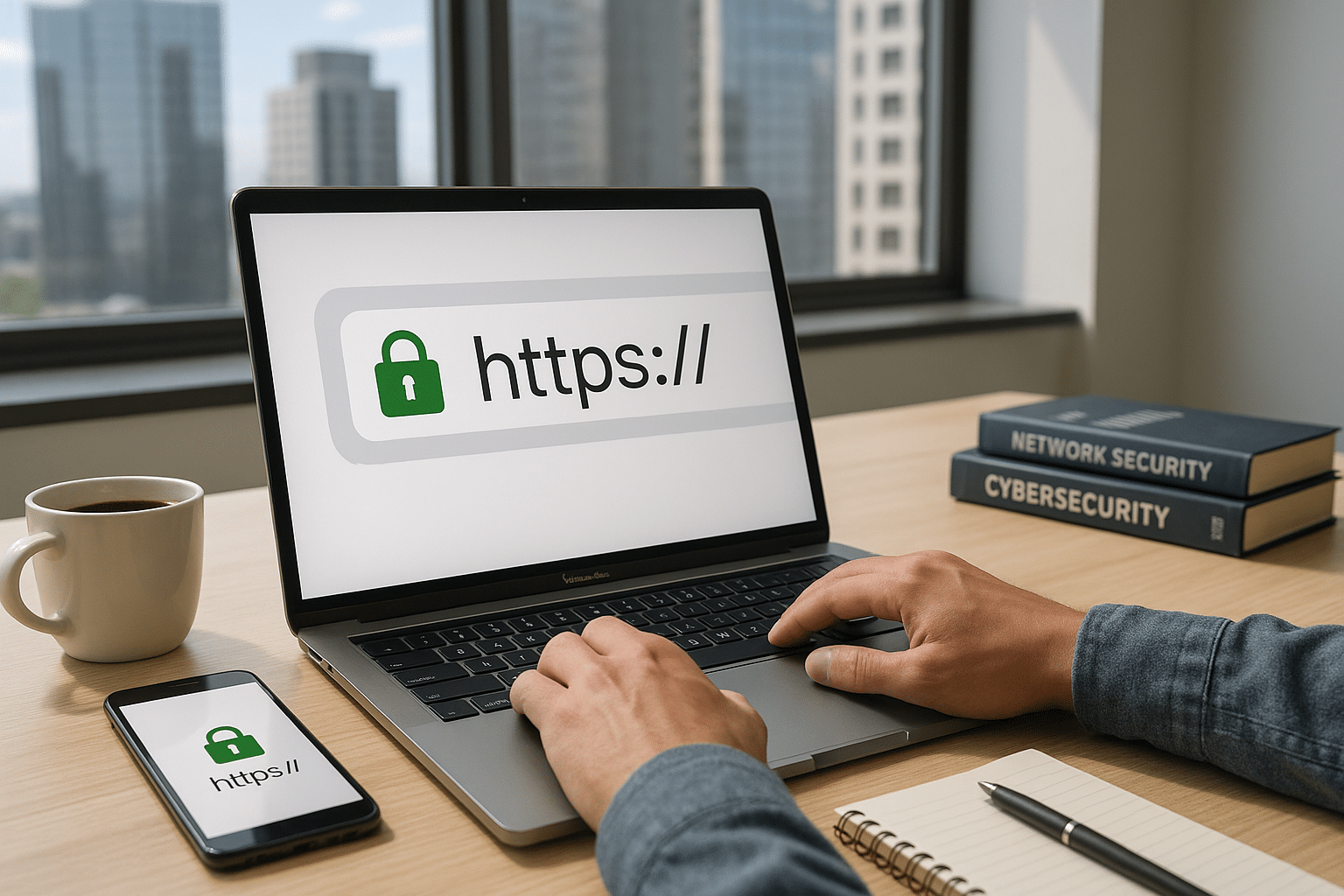Yet, it also holds unseen dangers, lurking in the form of data breaches, identity theft, and various forms of cyber-attacks. One of the critical frontlines in this ongoing battle for secure, safe, and private browsing is the implementation of HTTPS – a protocol for secure communication over a computer network. 🛡️
In this comprehensive guide, we will delve deeply into the importance of HTTPS for everyday browsing and explore how it contributes to creating a more secure digital world. For the uninitiated, HTTPS might seem like just another tech jargon. But in reality, it’s a crucial layer of security that protects the integrity and confidentiality of data between the user’s computer and the site. 💻
The article will break down the technical aspects of HTTPS, enabling you to understand its role and significance in the broader framework of internet security. We will demystify terms like SSL/TLS, Certificate Authorities (CA), and encryption, making it easier for you to comprehend how HTTPS works and why it’s essential. After all, the more you know, the better prepared you are to secure your digital world. 🌐
Next, we will focus on the reasons why HTTPS is vital for every website, regardless of whether it deals with sensitive information or not. In the current digital landscape, the absence of HTTPS can severely impact a website’s credibility, search engine ranking, and user trust. These facets often go unnoticed but hold substantial weight in securing your digital presence. 🌍
Further, the discussion will include practical steps on implementing HTTPS on your website. The process may seem daunting, but with the right information and tools, it can be straightforward. We aim to equip you with the knowledge you need to confidently navigate this process. 🔧
Finally, we will also explore the future of HTTPS, what new developments we can expect in the coming years, and how these advancements might shape our online interactions. Knowing where HTTPS is headed will help us understand how to adapt and stay ahead of the curve. 🚀
This article is written with the understanding that while our readers may not be technical experts, they are individuals who value their online security and privacy. We aim to make this content accessible and engaging, stripping away unnecessary complexity while still providing a thorough understanding of the subject matter. 🧠
So, join us on this enlightening journey into the realm of HTTPS. Whether you are a business owner, a website developer, or an everyday internet user, this guide will provide you with the knowledge and tools to enhance your browsing safety, maintain user trust, and secure your digital world. 🛠️
Let’s decode the intricacies of HTTPS and bolster your digital fortress against cyber threats. Are you ready to dive in? 🏊♂️
Secure Your Digital World: Understanding the Power of HTTPS
As our world grows increasingly digital, securing our online interactions has become critically important. One key element of this digital defense is HTTPS, the secure version of the Hypertext Transfer Protocol (HTTP) that your browser uses to communicate with websites. But what makes HTTPS so essential, and how does it work to keep your browsing safe and private? In this article, we’ll take a deep dive into these questions and more.
Why HTTPS Matters: The Basics
HTTPS stands for Hypertext Transfer Protocol Secure. It’s the secure version of HTTP, the protocol over which data is sent between your browser and the website that you’re connected to. The ‘S’ at the end of HTTPS stands for ‘Secure’, meaning all communications between your browser and the website are encrypted. This is important because the information you send on the internet is passed from computer to computer to get to the destination server. If the information is not encrypted, any computer in between you and the server can see your credit card numbers, usernames, passwords, and other sensitive information.
In comparison, when an SSL certificate is used, the information becomes unreadable to everyone except for the server you’re sending the information to, protecting it from potential hackers. But how does this process actually work? Let’s dive into the technical details to understand more.
How HTTPS Works: A Technical Dive
HTTPS operates through a system of trusted certificates known as the SSL/TLS protocol. When your browser attempts to connect to a website, it will first request the site’s SSL certificate. This certificate includes a public key that your browser uses to encrypt any data it sends to the site. Only the site’s private key can decrypt this data, ensuring that your information stays safe.
To illustrate this, let’s consider a hypothetical scenario. Say you’re making a purchase on an online store. When you enter your credit card information, your browser will use the site’s public key to turn that information into a jumbled mess of characters. This encrypted data is then sent to the site, which uses its private key to decrypt it back into your credit card number. Because only the site has the private key, your credit card number remains secure, even if a hacker manages to intercept the encrypted data.
In addition to encrypting your data, the SSL certificate also provides authentication. This means that you can be certain you’re sending your data to the right server and not to an imposter trying to steal your information. YouTube video: “How HTTPS works” by Simply Explained
HTTPS vs HTTP: A Comparative Table
| HTTP | HTTPS | |
|---|---|---|
| Data encryption | No | Yes |
| SSL certificate | No | Yes |
| Secure against interception | No | Yes |
As you can see, HTTPS offers significantly more security than its HTTP counterpart, making it the superior choice for any online interactions that involve sensitive data.
Implementing HTTPS: What to Know
Now that you understand the importance of HTTPS, you may be wondering how to implement it on your own site. The good news is that the process is simpler than you might think.
First, you’ll need to purchase an SSL certificate from a trusted provider and install it on your site’s server. This will enable your site to establish secure connections using the SSL/TLS protocol. Once this is done, you’ll need to configure your site to use HTTPS by default. This ensures that all traffic to your site is automatically redirected to the secure version.
Finally, you’ll need to update any hard-coded HTTP links to use HTTPS instead, and ensure that all of your site’s resources (like images and scripts) are also being served over HTTPS. If you’d like a step-by-step guide on this process, check out the YouTube video: “How to Install an SSL Certificate” by Namecheap.
Maintaining Trust with HTTPS
Implementing HTTPS isn’t just about securing your site—it’s also about building trust with your visitors. Today’s web users are more savvy than ever, and many look for the HTTPS indicator in their browser’s address bar before they’ll trust a site with their information. By using HTTPS, you’re signaling to your visitors that you take their security seriously, and that you’re committed to protecting their data.
Moreover, Google and other search engines give a ranking boost to HTTPS websites. So, switching from HTTP to HTTPS can actually improve your site’s SEO, making it easier for people to find you online. Therefore, using HTTPS is a win-win situation for both site owners and users, ensuring a secure, private, and optimized browsing experience.
Final Thoughts
In our increasingly digital world, the importance of HTTPS cannot be overstated. By securing our online interactions, it helps to keep our sensitive information safe from prying eyes, and maintains trust in the digital ecosystem. So whether you’re a site owner looking to protect your users’ data, or a web user who wants to keep your own information secure, understanding and using HTTPS is a crucial step towards a safer online world.

Conclusion
In conclusion, this article has covered a lot of ground. We began by discussing the importance of the digital transformation in today’s world, where industries and businesses are increasingly leveraging the power of technology. We’ve delved into the intricacies of Artificial Intelligence (AI), Machine Learning (ML), and their profound implications in the IT and Engineering sectors.
We’ve underscored the immense potential of these technological advancements and how they are reshaping our world. We’ve touched upon how AI and ML are not just buzzwords, but powerful tools that are propelling industries forward, making tasks more efficient and less labor-intensive. 🚀
Our journey through this technical landscape also emphasized the growing need for cybersecurity in an era where data is the new oil. We highlighted the crucial role of Information Security in protecting the confidentiality, integrity, and availability of data. 🔒
Moreover, we also explored the world of Cloud Computing, detailing its benefits such as scalability, flexibility, and cost-effectiveness. We’ve underscored how it is revolutionizing the way businesses operate and manage their resources. ☁️
In addition, we elucidated on the topic of Software Engineering, elaborating on various methodologies such as Agile, Scrum, and DevOps. We demonstrated how these practices are instrumental in delivering high-quality software products in a timely and efficient manner.
As we conclude, it’s worth remembering that understanding these complex concepts and technologies is not just for IT and engineering professionals. It’s for anyone who wants to keep up with the fast-paced digital world. 🌍
I hope this article has provided you with valuable insights, demystifying these technical topics and providing a clear and comprehensible explanation.
I encourage you to delve deeper, explore these topics further and see how you can apply them in your professional or personal life. Feel free to share this article with others who might benefit from it. Let’s keep the conversation going – comment below with your thoughts, queries, or insights about the topics discussed. 💬
Before I sign off, remember that technology is a tool, and like any tool, its impact depends on how we use it. Let’s use it to create a world that is more efficient, secure, and inclusive.
To further your understanding, here are some resources that you may find useful:
– [AI & Machine Learning: What it is and why it matters](https://www.ibm.com/topics/what-is-artificial-intelligence)
– [Information Security: Protecting the Enterprise](https://www.cisco.com/c/en/us/products/security/what-is-cybersecurity.html)
– [Introduction to Cloud Computing](https://aws.amazon.com/what-is-cloud-computing/)
– [The Basics of Agile and Scrum](https://www.atlassian.com/agile)
Keep learning, keep growing, and remember, in the realm of technology, the possibilities are endless. Until next time, happy reading! 📚
**REFERENCES**:
1. [IBM](https://www.ibm.com/topics/what-is-artificial-intelligence)
2. [Cisco](https://www.cisco.com/c/en/us/products/security/what-is-cybersecurity.html)
3. [Amazon Web Services](https://aws.amazon.com/what-is-cloud-computing/)
4. [Atlassian](https://www.atlassian.com/agile)



